By staff reporter LU RUCAI
By staff reporter LU RUCAI
CIZHONG is an administrative village of Diqing Tibetan Autonomous Prefecture in Yunnan Province. Though, with around 200 households of 1,000 residents, it is small, Cizhong is nonetheless well-known among travelers and religious enthusiasts in China.
More than 100 years ago, French missionaries built a Catholic church here. This renders Cizhong both a sacred place for Catholics and a tourist destination. A Catholic church in a Tibetan village? This may seem incongruous, but to local residents it is as natural as their daily salt.
Tibetan Catholics
Minling Mountain, one of the eight mountains of deep religious and cultural significance in Tibetan Buddhism, is situated in Deqen County of Diqing Tibetan Autonomous Prefecture. The mountain, at whose foot the famous Lancang River roars past, is also a gateway to Tibet from Yunnan. These towering precipitous mountains are surrounded by rivers, so the people living here seldom travel beyond them. This is where Cizhong Village is situated.
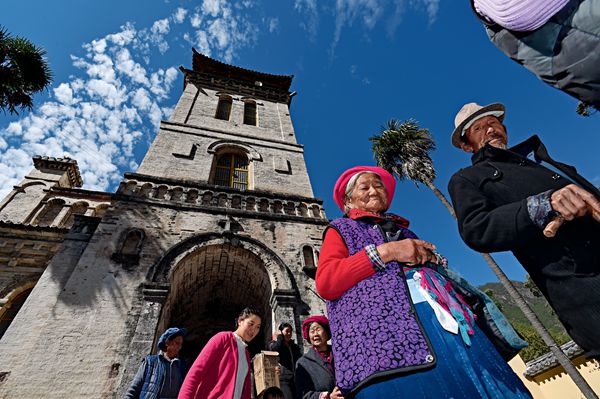
The Cizhong Catholic church congregation consists mainly of elderly Tibetan villagers.
Cizhong Church, in the French Gothic architectural style, is at the center of the village. Built in 1921, it was at that time a main Catholic church in Yunnan Province.
Of the 1,000 people from the Tibetan, Han, Lisu, and Naxi ethnic groups that live in Cizhong, 60 percent are Catholics. Now 88, village elder Xiao Jieyi is a rich source of historical facts about Catholic activities in Cizhong.
Xiao Jieyi, born in 1929, was given the Christian name Francois. He said that to European Catholics, Tibet has never lost its magnetism as a holy land, and they have long hoped to introduce their religion there. But they got no further than Yunnan, Tibet’s neighboring province.
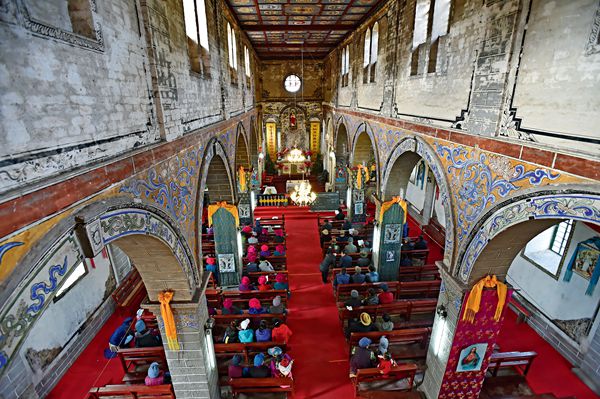
The church is built in a basilica style while Chinese elements are apparent in its interior.
Xiao Jieyi’s father came to Weixi County in Deqen from Dajianlu (now Kangding) in Sichuan with the French missionary Xu Wuzhong (Jean-Baptiste-Pierre-Victor Ouvrard, 1880-1930), when he was 18 years old. He later married Xiao Jieyi’s mother, a Tibetan girl from the local nunnery. Xiao Jieyi was their fourth child.
According to Xiao Jieyi, his father spoke fluent Latin, and was of immense help to several priests here. However, preaching Catholicism in this Tibetan village was not easy. Prior to Wu Xuzhong, the first pioneering Catholics to arrive in Yunnan dressed as merchants and studied the Tibetan language at local Tibetan Buddhist monasteries. They later introduced Western medicine and schools there. After gaining the trust of the local residents, to bring the voice of God to villagers these priests played gramophone records outside the church of Tibetan monks’ translation of Catholic doctrines. Gradually, Catholicism won some converts in this Tibetan Buddhist village.
Tsering Quzong, who lives next-door to the church, is a descendant of the Tusi (a local headman in the feudal society) family of the Naxi ethnic group. Her traditional Tibetan style house has a 100-year history that matches that of the 100-year-old church with which it stands shoulder to shoulder. According to Tsering Quzong, the land on which the church stands originally belonged to her family, as all land at that time was Tusi property. An area of land adjacent to her yard links her house with the vineyard south of the church.
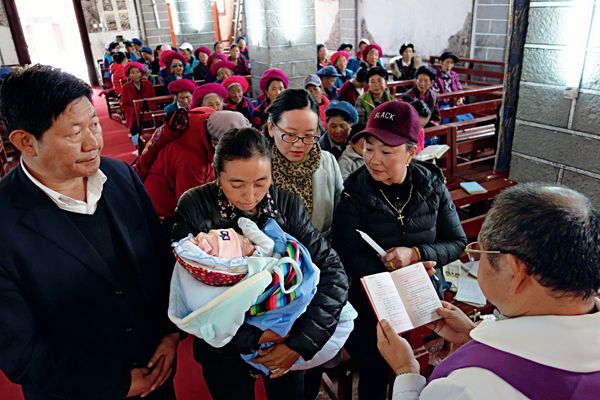
A christening ceremony.
The vineyard was introduced from France, having been cultivated by two missionaries, one of them Swiss and the other French. After 1949, the central government repatriated foreign missionaries from China. Consequently they left China in 1951. They were the last two foreign priests in Cizhong.
The vineyard, which Tsering Quzong manages, now belongs to Cizhong’s forest management station. “It’s said that the Rose Honey grape has long since disappeared in France,” she said. A couple of years ago, a few French grape growers came here to find seeds of this variety. Now almost every household in Cizhong and its neighboring villages grows grapes and makes wine both to enjoy and sell to tourists.
Xiao Jieyi has been learning the Tibetan language at the church since childhood. When he was 13, he was sent to learn Latin, Chinese, and Catholic doctrine as part of his training to be a priest. Later, in 1945, he was sent for further study at Kunming’s Catholic seminary, where he learned French and Latin for three years. Now 88 years old, he still remembers all the priests who came to the church, their hobbies and their ways. He praises Francois Gore as a learned scholar with a PhD who spoke fluent Tibetan and compiled several Tibetan dictionaries and books of scriptures. He also published a book in French about his 20-year life at the Tibetan village. Swiss priest Rovi excelled at the Lisu language, and the books and hymns he wrote and compiled are popular among believers. Another priest, Andrew, was quick tempered, but helped to build a road linking Cizhong with the Baihanluo Church by the Nujiang River. This considerably simplified travel between the two places for local residents.
Christian Names
In 1951, religious activities at Cizhong Church folded when foreign priests went back to their native countries. At the same time, a provincial-level primary school was set up here. Xiao Jieyi, due to his interactions with foreign priests, was sent to a labor camp in Lijiang. When, 30 years later, he came back to Cizhong Village, the church had fallen into disrepair and had a meager congregation.
In the 1980s, when religious freedom was just restored in China, no one dared to enter the church. Xiao Jieyi was the first to open its front door. Gradually, under his guidance, local Catholic activities resumed.
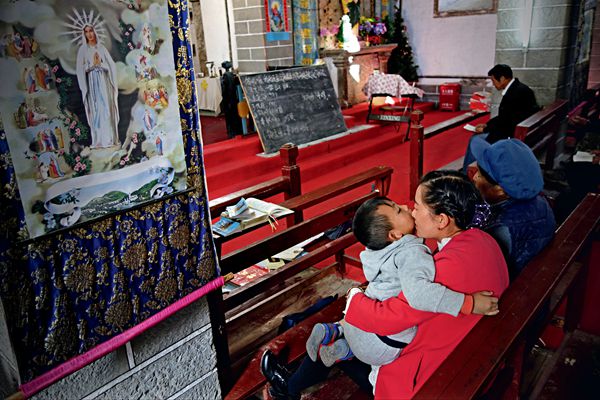
A mother and her child share a sweet moment.
Xiao Jieyi showed us the handwritten stories in his home about Cizhong Church. The love he harbors for his land and religion shone through as he told us the history of Cizhong and its people. He knows, he told us, hundreds of hymns. He sang us a few, and also the French folk song Le Coucou.
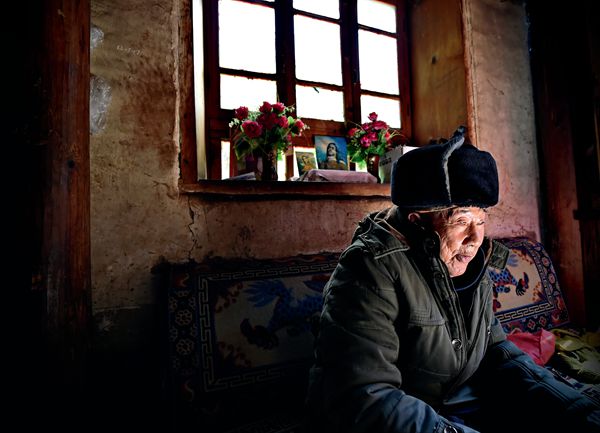
Xiao Jieyi.
Wu Gongdi, Christian-named Augustine, was born in 1949, and is now head of the Roman Catholic Church in Cizhong. Rovi baptized him when he was eight days old. He told us that his great grandfather walked all the way from Tibet to Yunnan and settled here, and married a local girl Christian-named Mary. After they married, his great grandfather converted from Tibetan Buddhism to Catholicism. The family has since remained Catholic.
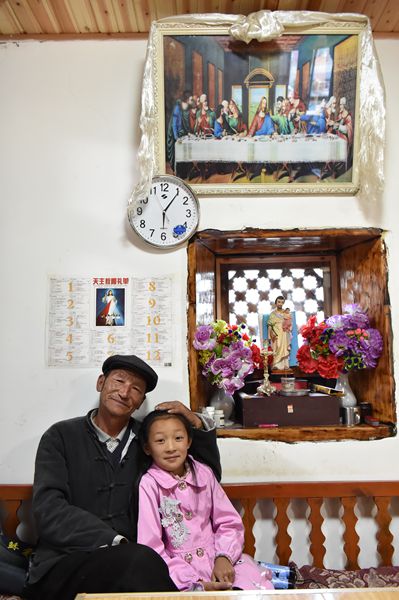
Wu Gongdi and his granddaughter Maria.
In the ensuing 20 years after the resumption of religious activities, Cizhong Church had no full-time priests. Every Christmas, therefore, a locum priest came from Dali parish to help. Wu Gongdi and his colleagues now manage the daily affairs of the church while Xiao Jieyi, when in good health, comes to lead the church choir on Sundays.
Wu Gongdi’s granddaughter Maria, her Chinese name Zhang Ruiying, is in the fourth grade of a primary school. Among Catholics of Cizhong, in the past they had solely Christian names such as David, Teresa, and Angela. But now, to apply for an ID card they need a Chinese name, and people often pick one randomly. It’s therefore common here for an old man and his granddaughter not to share the same Chinese family name, although it’s unusual in the rest of China. Maria says that she sometimes goes to church with her grandpa, but not often. “We have freedom of religious belief according to the current law. But at the same time, parents cannot force their children to follow any particular religion,” Maria said. Wu Gongdi believes that all religions, whether Tibetan Buddhism, Catholicism or the Naxi Dongba faith have in common the mission of encouraging people to be good.
New Priest in the Village
At 9:00 am every Sunday, the Catholics of Cizhong come to church. Older women, their grandchildren in tow, wear traditional Tibetan dress. Like many other places in China, the younger villagers have gone to cities to be migrant workers, leaving their children and aged parents behind.
In 2008, the situation where Cizhong church had no resident priest changed. Yao Fei from Inner Mongolia now fulfills this function. Before coming here he worked for years in churches in South China’s Hubei and Fujian provinces. To him, not speaking the Tibetan language is the main difficulty. “In the early days, the French and Swiss priests could all preach in Tibetan, which helped them win the trust of the congregation,” Yao Fei said. “Although they can understand my Chinese preaching, they prefer it in the Tibetan language.” In his spare time, he studies Tibetan and local customs in the Tibetan-inhabited region. He is always invited to wedding ceremonies, funerals, and birthday parties. “Whether you are a Buddhist or a Catholic, many things connect. Here, villagers of different religions get along pretty well with each other,” Yao Fei said.
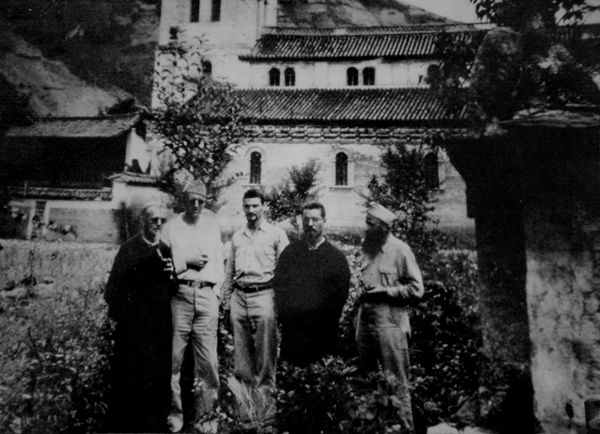
A historical photo: a few American soldiers at the Cizhong Church during the Chinese People’s War of Resistance against Japanese Aggression.
Dixuan Uncredited photos by Yu Xiangjun
It was a Sunday morning. As the church filled, a line formed outside the confessional. Rays of sunlight splintering through the arched windows illuminated the murals, painted more than 100 years ago on the church walls. Though Western culture leaves its traces on the church exterior and interior, many decorations within have distinct Chinese features. There are on its walls, for example, many pictures in the Tibetan and Bai styles. Yao Fei said that when he first came here, he taught villagers nothing more than the fundamental Catholic tenets. But he discovered that people here also sought guidance in other problems, such as marital and neighborhood relations. When listening to confessions, therefore, he offered suggestions, based on the Catholic doctrines, on how to be tolerant of others. On this particular day, apart from the normal mass, he also baptized a village newborn.
After mass, Wu Gongdi waited for Yao to finish his ministrations because he had asked him to hold a family mass in his newly refurbished house. “It’s been a long time since I held a family mass,” Wu said. When his first and second sons were born, religious activities were forbidden in China, so he had to hold clandestine midnight baptisms. These days, religious activities are a part of local village life.
Different from Catholic churches in other places, the mass in Cizhong Church is held on Monday, Wednesday, Friday evenings and Sunday mornings. But the church is open daily to villagers and visitors. In 2006, Cizhong Church was approved as a Major Historical and Cultural Site Protected at National Level. It has since drawn visitors from around the world, including France.
This international influx has benefited Tsering Quzong’s family inns, which are in growing demand. After seeing the Cizhong church, visitors often go to her house to look at the venerable and characteristic Tibetan handicrafts and other artifacts there and observe traditional Tibetan lifestyle. Tsering Quzong found a franc minted in 1913 which had been broken in half, so signifying her great grandfather’s interaction with French missionaries. She had another intact franc which her brother had taken to Shanghai to be appraised. “We will never sell it, we just want to know its history,” she said.
Life in this village near the Nujiang River follows its daily course, as the mani stone piles on the village outskirts and the Catholic Church at its center continue their silent dialogue. In the church graveyard, large trees shade the graves of Wu Xuzhong and the Swiss missionary.
Wu Gongdi said that a new priest, freshly graduated from a missionary school who knows the Tibetan language, would be coming to Cizhong Church. This new arrival will help the local Catholics to sustain their faith.